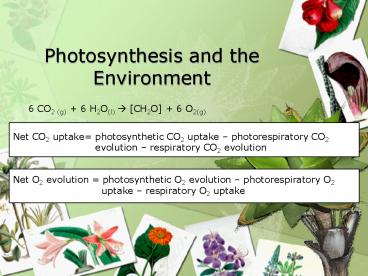Photosynthesis and the Environment - PowerPoint PPT Presentation
1 / 7
Title:
Photosynthesis and the Environment
Description:
6 CO2 (g) + 6 H2O(l) [CH2O] + 6 O2(g) Net CO2 uptake= photosynthetic CO2 uptake photorespiratory CO2 evolution respiratory CO2 evolution – PowerPoint PPT presentation
Number of Views:20
Avg rating:3.0/5.0
Title: Photosynthesis and the Environment
1
Photosynthesis and the Environment
6 CO2 (g) 6 H2O(l) ? CH2O 6 O2(g)
Net CO2 uptake photosynthetic CO2 uptake
photorespiratory CO2 evolution
respiratory CO2 evolution
Net O2 evolution photosynthetic O2 evolution
photorespiratory O2 uptake
respiratory O2 uptake
2
Light Intensity and the Rate of Photosynthesis
- Irradiance light intensity per unit area of
leaf - Light response curve shows the effect of
increasing irradiance on the rate of
photosynthesis - Light-compensation point - CO2 uptake equals CO2
evolution - Light-saturation point occurs at the irradiance
level at which the carbon fixation reactions
reach a maximum overall rate
3
Temperature and the Rate of Photosynthesis
- The light reactions are not affected by
temperature - Calvin cycle is affected because of enzymes
- Optimal temperature is between 10OC 30OC
- Above 40OC enzymes may become denatured
Influence of some factors on the rate of
photosynthesis
4
Oxygen Concentration and the Rate of
Photosynthesis
- High oxygen levels have an inhibitory effect on
photosynthesis - Competition between O2 and CO2 for the active
sites on rubisco
5
Photosynthetic Efficiency
- Quantum yield net CO2 uptake per unit of light
energy (photons) absorbed - C3 plants are more efficient at lower
temperatures and C4 plants are more efficient at
higher temperatures
6
Sun Plants vs. Shade Plants
- Shade plants have thinner, broader and greener
leaves - Shade plants more efficient at harvesting light
at low intensities - Sun plants have a higher light-compensation point
- Sun plants have a higher light-saturation point
7
Cheaper New More Effective Solar Cells Imitate
Photosynthesis - They employ synthetic pigments
imitating the natural ones - Softpedia































